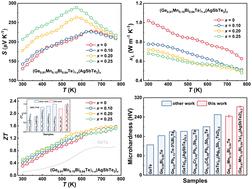无铅立方锗基复合材料热电性能和力学性能的同时增强
IF 9.5
2区 材料科学
Q1 CHEMISTRY, PHYSICAL
引用次数: 0
摘要
GeTe是一种具有优异热电性能的中温热电材料。然而,在700k附近发生的菱形向立方的相变会引起热膨胀系数的变化,从而导致器件内应力的产生,影响器件的工作效率。本文报道了将Ge0.81Mn0.15Bi0.04Te与AgSbTe2合金化,以进一步降低相变温度,优化热电性能。Ag和Mn的共掺杂增加了态密度的有效质量,导致塞贝克系数的增强。此外,由于各种声子散射机制的共同作用,晶格热导率下降。与AgSbTe2合金化后,平均ZTave值从300 K提高到773 K,立方(Ge0.81Mn0.15Bi0.04Te)0.8(AgSbTe2)0.2,同时维氏显微硬度从243 HV提高到283 HV。本文章由计算机程序翻译,如有差异,请以英文原文为准。

Simultaneous enhancement of thermoelectric performance and mechanical properties in lead-free cubic GeTe-based composite materials
GeTe is a promising mid-temperature thermoelectric material that exhibits excellent thermoelectric performance. However, the rhombohedral-to-cubic phase transition occurring near 700 K causes a change in the coefficient of thermal expansion, leading to internal stresses in the device and affecting its working efficiency. In this work, we reported the alloying of Ge0.81Mn0.15Bi0.04Te with AgSbTe2 to further reduce the phase transition temperature and optimize thermoelectric performance. The co-doping of Ag and Mn increased the effective mass of the density of states, resulting in an enhancement of the Seebeck coefficient. Moreover, the lattice thermal conductivity decreased due to the combined effects of various phonon scattering mechanisms. After alloying with AgSbTe2, the average ZTave value increased to 1.18 from 300 K to 773 K in cubic (Ge0.81Mn0.15Bi0.04Te)0.8(AgSbTe2)0.2 and, simultaneously, the Vickers microhardness was enhanced from 243 HV to 283 HV.
求助全文
通过发布文献求助,成功后即可免费获取论文全文。
去求助
来源期刊

Journal of Materials Chemistry A
CHEMISTRY, PHYSICAL-ENERGY & FUELS
CiteScore
19.50
自引率
5.00%
发文量
1892
审稿时长
1.5 months
期刊介绍:
The Journal of Materials Chemistry A, B & C covers a wide range of high-quality studies in the field of materials chemistry, with each section focusing on specific applications of the materials studied. Journal of Materials Chemistry A emphasizes applications in energy and sustainability, including topics such as artificial photosynthesis, batteries, and fuel cells. Journal of Materials Chemistry B focuses on applications in biology and medicine, while Journal of Materials Chemistry C covers applications in optical, magnetic, and electronic devices. Example topic areas within the scope of Journal of Materials Chemistry A include catalysis, green/sustainable materials, sensors, and water treatment, among others.
 求助内容:
求助内容: 应助结果提醒方式:
应助结果提醒方式:


